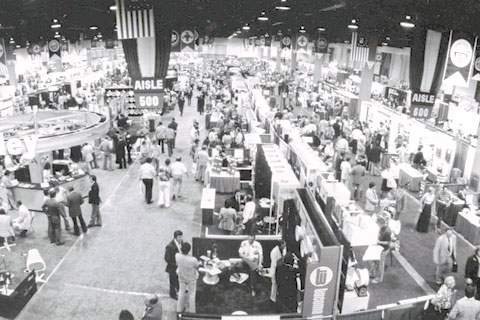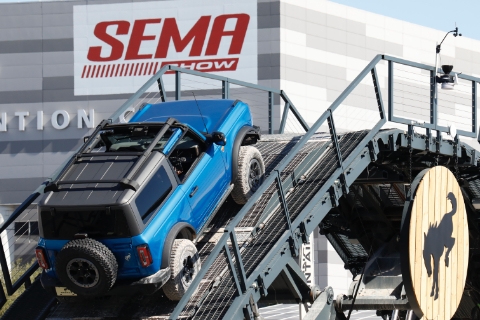SEMA News—August 2017
PEOPLE
By Douglas McColloch
2017 SEMA Hall of Fame
GiGi Carleton, Doug Evans, Barry Meguiar
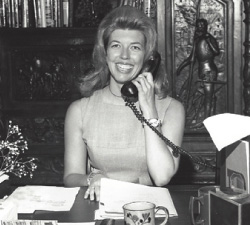 | 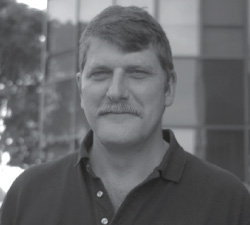 | 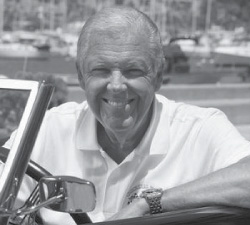 |
| GiGi Carleton | Doug Evans | Barry Meguiar |
The SEMA Hall of Fame was established in 1969 to honor the contributions of leaders in the automotive aftermarket industry whose creativity, diligence, generosity and industriousness have significantly contributed to the industry’s growth. The award is the automotive aftermarket’s highest honor, and the Hall celebrates the legacies of a pantheon of automotive legends from the racing, manufacturing and media sectors.
For 2017, the SEMA Hall of Fame inducts GiGi Carleton, Doug Evans and Barry Meguiar—three individuals whose unique contributions to the automotive specialty-equipment marketplace have helped to make the SEMA Show one of the world’s largest and most esteemed industry trade shows.
GiGi Carleton
Success Through Dedication and Perseverance
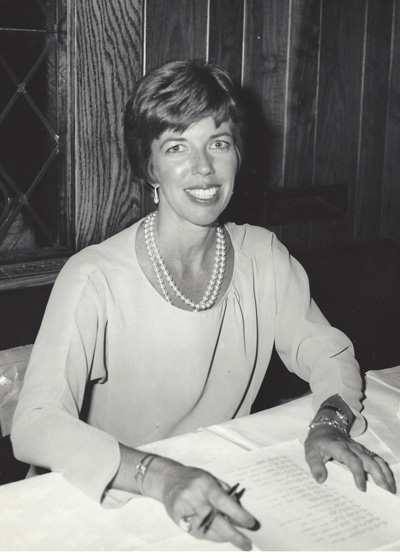 “I was only doing my job.” That’s how 2017 Hall of Fame inductee GiGi Carleton described her 50-plus years of working for Petersen Publishing Company and, more recently, the Margie and Robert E. Petersen Foundation. But as the late Robert Petersen's executive assistant and special events coordinator and in later years party planner for trade show exhibitors and advertisers, she played a pivotal role in the marketing and promotion of motorsports across the United States, and her dedication and perseverance were instrumental in organizing and successfully launching the inaugural SEMA Show 50 years ago.
“I was only doing my job.” That’s how 2017 Hall of Fame inductee GiGi Carleton described her 50-plus years of working for Petersen Publishing Company and, more recently, the Margie and Robert E. Petersen Foundation. But as the late Robert Petersen's executive assistant and special events coordinator and in later years party planner for trade show exhibitors and advertisers, she played a pivotal role in the marketing and promotion of motorsports across the United States, and her dedication and perseverance were instrumental in organizing and successfully launching the inaugural SEMA Show 50 years ago.
A native of Los Angeles, Carleton graduated from Immaculate Heart High School in Hollywood. Her father had recently passed away and with her mother supporting two younger siblings, she took a position working in the radio and TV division of a local advertising agency. Shortly thereafter, she moved to a company that offered an early version of pay TV known as subscription television. That company folded for lack of demand, but Carleton received a phone call shortly thereafter that would change the course of her life.
“I got a call from a person whom I had worked with in the advertising field who knew that I was good with detail, and he gave my name to a fellow called Patrick O’Rourke, who was working for Robert Petersen on a consultant basis and who needed some help putting on the Motor Trend/NASCAR 500 stock car race at Riverside International Raceway. It was a six-week contract position.”
“Here’s the thing,” she recalled: “At the time I didn’t even know what a stock car was. What’s NASCAR? What’s a stock car? I had no idea what Patrick was talking about! Patrick told me, ‘That’s okay, you’ll learn, and I know you’re good with details.’”
Eventually, the six-week contract turned into an offer of a full-time job in the special events department at Petersen Publishing Company.
“I went to work for six weeks,” Carleton noted, “and I never left.”
She served the Petersens in various executive capacities until Margie Petersen’s death in 2014, and she remains the president of the Margie and Robert E. Petersen Foundation.
Life in the early days at Petersen Publishing, with its legendary headquarters at 8490 Sunset Boulevard, could be fast and frantic, and event planning took place at a breakneck pace.
“Mr. Petersen was always coming up with ideas for new events,” Carleton remembered, “He’d say to Patrick, ‘I want this new event six weeks from now or two months from now,’ when normally you’d need six months to organize something like what he had in mind. Mind you, this was just Patrick and me doing this—we were the entire special events division! I don’t know how we managed to do it all, but we did put in a lot of 12-hour days.”
As she gained experience in special events, Carleton’s role in the company began to expand. Due to her background in radio and TV, she was also a production assistant for Robert E. Petersen Productions. Petersen appointed her executive secretary in 1967 and assistant to the chairman of the board some 10 years later.
Carleton’s roster of events was diverse and wide-ranging. Besides helping to organize the aforementioned Motor Trend race at Riverside, she worked on the Hot Rod East-West drag-race series, the 1965 Motorama car show at the Pan-Pacific Auditorium in Los Angeles, and on a mezzanine-level exhibit at the New York Auto Show at the old New York Colosseum.
After Petersen acquired the performance-industry trade journal Hot Rod Industry News in the mid-’60s, she was assigned to assist Alex Xydias for an event to build awareness of the publication: the inaugural Speed Equipment Manufacturer’s Association show. It was an industry-only trade exhibition held at Dodger Stadium in 1967, which is better known today simply as the SEMA Show. Fifty years on, Carleton still vividly remembered the event, which took place outdoors on the stadium’s club-level concourse.
“It was in January, and it was freezing cold that day,” she said. “There were 99 booths. The manufacturers came from all over the United States—some locally, some from as far away as the Midwest—and everyone stayed at the old Ambassador Hotel on Wilshire Boulevard. No one was sure how well a show like this would turn out, because no one had ever done anything like it before. And it was a huge success! We couldn’t believe it!”
Looking back, she surmised that “it was one of those things where the timing was right, the economy was good, people had money—and many of the exhibitors wrote so many orders at the first show that they could hardly wait for the second one,” which was relocated the following year to the recently opened Anaheim Convention Center.
When Carleton heard that she had been nominated to the SEMA Hall of Fame, she said that she was totally flabbergasted.
“I was thrilled to death, and I consider it a huge honor to be included with all of those people in the Hall of Fame, whether they have passed on or are still with us,” she said. “A lot of [the inductees] I’ve known for many years, so it’s really a thrill. Looking back on it, though, I was only doing my job!”
Carleton still maintains an active schedule. She continues to manage the Petersen estate, and her work for the Petersen Foundation keeps her “busier than I can tell you.” Among the foundation’s most noted acts of philanthropy in recent years have been a gift of $8.5 million to Children’s Hospital of Los Angeles and an overall $250 million gift to the Petersen Automotive Museum, which included all the Petersen collection of cars, building and founding costs, which she is still involved from time to time with consultant duties.
Her advice was particularly sought during the controversial remodel of the museum in 2015, and Carleton thinks that Bob Petersen would have likely approved of its final iconic design.
“If he were here, I’m sure he’d say something like, ‘You’ve got to change with the times. You can’t stay stuck in the mud and not be afraid to try new things.’ That’s the kind of person Mr. Petersen was.”
Doug Evans
Tireless Advocate for the Industry
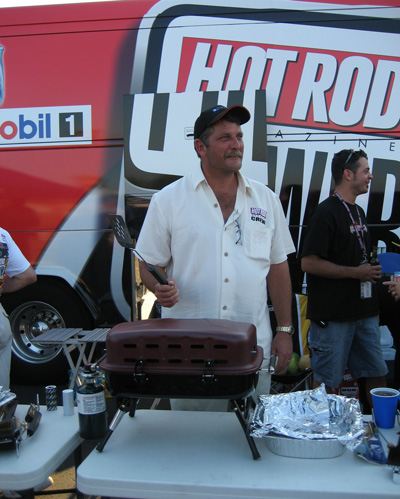 Of all the members of the automotive specialty-equipment industry who have influenced the growth of SEMA since the turn of the millennium, few have left a greater impression, and done so with more dedication, than outgoing SEMA Board Chairman Doug Evans. From his work on behalf of the SEMA Action Network to the SEMA Businesswomen’s Network and the SEMA Launch Pad, to name only a few, there’s scarcely been an initiative within SEMA during the past two decades that Evans hasn’t worked to promote. His tireless efforts to expand SEMA’s partner outreach and his advocacy on behalf of motorized recreation have earned him the admiration of the specialty automotive market worldwide.
Of all the members of the automotive specialty-equipment industry who have influenced the growth of SEMA since the turn of the millennium, few have left a greater impression, and done so with more dedication, than outgoing SEMA Board Chairman Doug Evans. From his work on behalf of the SEMA Action Network to the SEMA Businesswomen’s Network and the SEMA Launch Pad, to name only a few, there’s scarcely been an initiative within SEMA during the past two decades that Evans hasn’t worked to promote. His tireless efforts to expand SEMA’s partner outreach and his advocacy on behalf of motorized recreation have earned him the admiration of the specialty automotive market worldwide.
Evans, a Chicago native, made a connection with cars at an early age and in a hands-on fashion. A boyhood devotee of Hot Rod magazine, he happened to have an older brother “who was a terrible driver. Every couple of years he’d wreck a car, and we’d have it up on stands in the backyard trying to put it back together. That’s how I started working on cars, and by the time I was 18, I was doing full-on rebuilds and paint jobs. Basically, I learned as I went along and from whatever I could learn from the pages of Hot Rod.”
In the late ’70s, having graduated from college and completed a stint in the U.S. Marines, Evans was ready to “spend some of the money I’d saved in the military on a cross-country motorcycle tour,” but with the economy faring poorly at the time, he reconsidered and soon landed a position as a media planner at Young & Rubicam—the nation’s largest advertising agency at the time.
“That was my first exposure to the agency side of the automotive business,” he said, noting that the experience suggested a more lucrative career path down the road. “When I discovered that the sales guys at the magazines who were pitching us for advertising dollars were making four times more money than I was, I thought it might be a good idea to get into that side of the business.”
Eventually his thoughts turned to Hot Rod, and the company that published it.
As it happened, Petersen Publishing Company had recently launched a new publishing division that included Hot Rod and which was in need of sales personnel, and Evans soon found himself working for the magazine he’d read so faithfully in his youth. He recalled the ’80s at Petersen Publishing Company fondly.
“It was a glorious time to be in the publishing industry,” he said. “The energy level at the place was so high, every day was like a new adventure. The business was growing by leaps and bounds each year, and it was a tremendous honor to work with people like Bob Petersen and [fellow 2017 inductee] GiGi Carleton. Sometimes I just couldn’t believe that I had the good fortune to be working for the same magazine I’d read so many years ago.”
After departing for stints at Condé Nast, Hachette and The Promotion Company (now Family Events) in the ’90s, he returned to the fold at the old Petersen company, which had been sold in his absence and has been known by several names in the years since (E-Map USA, Primedia, Source Interlink Media and, most recently, The Enthusiast Network).
During his last tour of duty, this time as executive vice president and group publisher, he oversaw comprehensive redesigns of some of the most iconic brands in the enthusiast-publishing industry, including Hot Rod, Car Craft, Four Wheeler, and Street Rodder—in all, three dozen titles. In addition, he oversaw the marketing and promotion of some 95 annual specialty projects and events such as the Hot Rod Power Tour and the Amsoil Engine Masters Challenge. He also played a key role in overseeing the transfer of the company’s massive photo archive—dating back to the first issue of Hot Rod in 1948—to the Petersen Automotive Museum, where it could be preserved and made available for research and to the public.
After departing the publishing company, Evans served as executive vice president and chief operating officer at Luken Communications, a national multicast TV network provider with a roster of properties that includes the enthusiast Rev’n network. He is now the director of business development of events at Bonnier Corporation, where he contributes to the company’s entire portfolio of branded enthusiast events, including the popular Family Events series (4-Wheel Jamboree Nationals, Monster Truck Nationals, Off-Road Expo and more).
Evans’ roots at SEMA go back over three decades, and he still vividly recalls his first SEMA Show in 1984.
“It filled up the entire central hall [of the Las Vegas Convention Center], and I was just blown away by the place and by the idea that such a show could even be put together,” he said. “More than anything, I remember thinking to myself how amazing it was that I was actually getting paid to do this!”
Evans has been awarded myriad honors and accolades for all his contributions to the industry. He is a member of the Automotive Restoration Market Organization (ARMO) Hall of Fame, and he served three terms on ARMO’s select committee. He was named SEMA’s Person of the Year for 2009 and Mentor of the Year by the SEMA Businesswomen’s Network in 2012. He has served three terms on the SEMA Board of Directors. He has served one term as chair-elect and one term as chairman.
Evans has led a number of SEMA outreach initiatives over the years. He was an early champion of the SEMA Political Action Committee (PAC) and has served as chairman of the PAC for 15 years. An activist dating back to his term as student-body president at Valparaiso University, his alma mater, Evans played a key role in the creation of the SEMA Action Network, the online advocacy initiative that keeps millions of auto enthusiasts informed on a daily basis about public policy initiatives that could affect their pastimes and livelihoods.
He has worked extensively with government agencies to preserve access to motorized recreation, most notably on the reclamation of the Bonneville Salt Flats as chairman of the Save the Salt Coalition, and he has been active in expanding SEMA’s youth outreach via programs such as SEMA’s Car Camp and the SEMA Career Fair.
When asked about his induction into the Hall of Fame, Evans was gracious and understated.
“Frankly, I was shocked when the announcement was made,” he said. “To be included alongside people of the caliber of GiGi Carleton and Barry Meguiar, it’s just unbelievable. And looking down the list of names on the Hall of Fame roster going back to the ’60s, I’m struck by just how many people on there are people I followed when I was a kid reading Hot Rod. It’s just an incredible honor—words don’t do it justice.”
While his term as Board chairman has drawn to a close, Evans has no plans to cease working day-to-day on ongoing SEMA initiatives.
“I’m still very much interested in the political and advocacy side of our business,” he said, “and I plan to continue my work with the SEMA PAC, working with government officials on policy matters that affect our members and on anything else where SEMA feels that I could make a positive contribution. Working with SEMA has been one of the joys of my life, and I very much look forward to continuing my relationship with the organization.”
Barry Meguiar
A Pioneer Who Saw the Value of Passion
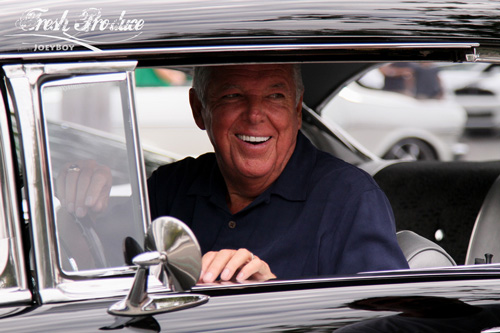 Passion: If a person can be described in a single word, it would be hard to find one more apt for Barry Meguiar, president and third-generation leader of the car care products company that bears his family name. Becoming the leader of this small family business with a dozen employees and transforming it over four decades into a global company offering up 100’s of products in 120 countries, Meguiar has worked unceasingly to popularize the specialty automotive market, and he’s done it with an unyielding passion—for his products, for his profession, for his industry and, most of all, for his customers, the millions of “car guys” whose cause he has championed tirelessly.
Passion: If a person can be described in a single word, it would be hard to find one more apt for Barry Meguiar, president and third-generation leader of the car care products company that bears his family name. Becoming the leader of this small family business with a dozen employees and transforming it over four decades into a global company offering up 100’s of products in 120 countries, Meguiar has worked unceasingly to popularize the specialty automotive market, and he’s done it with an unyielding passion—for his products, for his profession, for his industry and, most of all, for his customers, the millions of “car guys” whose cause he has championed tirelessly.
“I was born into the business that my grandfather started in 1901,” Meguiar recalled. By the time he was in college, he became the company’s accounting department, keeping the books for a family-scale enterprise with annual gross sales of roughly $600,000.
The longer he worked for the company, however, Meguiar saw a bigger and brighter future for it—if he could convince his fellow family members.
“My family had nothing but disdain for the retail market,” he explained, “being wholly committed to only making professional polishes for car dealers and body shops. But because of the performance of our products, most custom painters across the United States started using them and giving them to the owners of every car that they painted. Our products started showing up in car shows all over the country. So one day I called the family members together and said, ‘Whether we like it or not, we’re in the retail business.’ This was in 1969.”
One of Meguiar’s inspirations occurred a few years earlier, when Noel Carpenter, publisher of the monthly trade journal Hot Rod Industry News, hosted an industry-only trade show that would later be acquired by Petersen Publishing Company and rebranded as the SEMA Show.
“I attended the very first SEMA show with our old packaging in the ballroom at the Disneyland Hotel back in 1963,” he said. “There were only a handful of exhibitors there, and Noel created this trade show for the high-performance industry. I got to watch the beginnings of the industry, and I’m one of the few left from those days still standing. It’s been quite a ride.”
Still, the early precursors to the SEMA Show had little initial effect on Meguiar’s business.
“The first shows didn’t impact our business much because our professional products weren’t available in retail stores,” he explained. “So when I went to car shows across the country, I was attacked by car guys asking, ‘What’s wrong with you guys? Why do I have to go to my paint shop to get your products instead of my auto parts store?’ Against the will of our family there was this pent-up demand for Meguiar’s going retail, and I saw that as a big opportunity. Selling the family on that idea was my toughest ever sales job.
For the next four years, Meguiar devoted his life to “flying a lot, traveling to auto shows, demonstrating our products and learning as I went along. I was a young guy back then, and all I knew was how to buff a car. I didn’t know anything about retail or packaging or marketing or anything like that.”
Meguiar’s approach to marketing was simple and direct: Approach every attendee and demonstrate the product, then give away a bottle free of charge, asking attendees to display Meguiar’s signs if they liked the results. Soon, Meguiar’s signs began popping up prominently at auto shows across the country.
While the product’s public profile grew gradually through hands-on demonstrations and word of mouth, retailers were still lukewarm to stocking the Meguiar’s product line.
“They thought it appealed to too small a market share,” Meguiar said. “They didn’t care about car guys. Then I’d explain to retailers that ‘car guys’ were different from their average customers. Whereas the average consumer might wax his car only once or twice a year, our people—who were a unique, separate part of the marketplace—they might be waxing their cars every week, 50 times a year. Not because they felt obligated but because they wanted to. That’s their joy, and their passion.” (That word again.)
“Eventually,” Meguiar continued, “I was able to get the product into some speed shops, then into some chains, and finally to the point where I could get onto the shelves of major retailers—and everywhere Meguiar’s products got on shelves, they not only sold but grew their automotive department. And the retailers came back at us like, ‘Wow, you really are bringing in new customers!’ I knew I was being a pioneer for every SEMA member who wanted to go retail.
The process of using a small family branded product line for professionals as a launching pad for going into the retail market place took four years, and the turning point took place at the SEMA Show in 1973.
“That’s when we introduced our new face for retail with the scripted logo, which I developed during that four-year period and that gave the product a whole new identity,” Meguiar said.
For many years, Meguiar’s exhibited both at the SEMA Show and the APAA Show in Chicago which transitioned into the AAPEX Show in Las Vegas. “The AAPEX show was important because that’s where the big buyers, the heavy hitters—the Walmarts, the auto chains, what have you—were focused. But there was no passion at AAPEX,” Meguiar said. “So one day I put a TV camera on our booth at the SEMA Show to show the buyers at AAPEX how cool the SEMA Show was. As we captured their interest, we drove them over to SEMA to experience SEMA for themselves and they were hooked. That was a game changer! Up to that point, most major retailers didn’t even know SEMA existed.”
“When we finally decided to show only at SEMA—this was sometime in the late ’90s, I believe—we brought even more people over from AAPEX, since they couldn’t find us at the Sands anymore.”
Asked why he decided to settle exclusively on the SEMA Show after years of exhibiting at both venues, Meguiar was emphatic: “The passion. SEMA is a passion show, and we’re a passion company with a passion brand. The business guys attended AAPEX, but the ‘car guys’ attend SEMA, and they are our world.”
Into the ’90s and ’00s, Meguiar expanded his industry outreach as SEMA’s brand ambassador par excellence.
“I felt like we needed to get more exposure for SEMA to car guys nationally and globally,” he said. “We needed to do broadcasting, and I had a radio show (“Car Crazy”), so we set up a live radio show at SEMA, broadcasting from the GM, Ford and Chrysler booths and finally a designated space provided by SEMA. Then we decided to go into TV, so SEMA offered to build a stage for us. We started broadcasting live from the Show as “SEMA TV” around 15 years ago. On average, I’ve done 100 interviews every year over the four days of the Show. To my knowledge, no one has ever broadcast live interviews for four days at a trade show, viewed live on monitors throughout the show and on a JumboTron as well as being shown in more than 90,000 hotel rooms. On top of that, we’ve done two “Car Crazy” TV shows from SEMA every year that have aired globally to millions of car guys...generating great PR for SEMA.”
A lifetime devoted to the specialty automotive market and to the “car guys” who sustain it have yielded Meguiar countless accolades over the years, among them being presented a Petersen Museum Icon of the Year award; being appointed grand marshal of such events as America’s Concours d’Elegance at St. Johns, the Copperstate 1000 and the Woodward Dream Cruise; and receiving lifetime achievement awards at the Route 66, Autorama and Grand National Roadster shows.
He’s also an avid collector, and in 2015, his 1901 Duryea (a tribute to the year his grandfather started the family business) was the oldest car on the lawn at the Pebble Beach Concours. (However, he credits his first car—a ’57 Chevy Bel Air—as his “pride and joy.”) He’s also been named Alumnus of the Year by Point Loma Nazarene University and Layman of the Year by the General Council of the Assemblies of God.
Reflecting upon his induction into the SEMA Hall of Fame, Meguiar waxed grateful: “SEMA has been such a big part of my life. It’s part of my family. Throughout all the years, I’ve promoted SEMA as much as I’ve promoted my own products. To do all that, and now this, it’s the cherry on top of the cake. All of my heroes are in the SEMA Hall of Fame, and it’s humbling to be associated with them. I’m greatly honored, I really am.”


